Sculling Without The Oar
by Andy Brenner
Continued
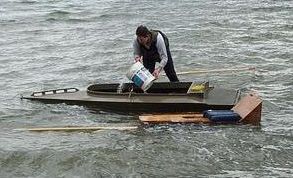
This boat was designed and built with weight as a major concern. Safety was also a big factor as this boat is often used in freezing temperatures. The picture at the right is me performing a sink test on the boat. The idea was to have a boat that was unsinkable. It can actually support my weight when full of water. One thing I learned from the sink test is that the boat is extremely unstable when completely full of water. It was a good warning against overloading the boat.
This 11' 4" boat gets some very hard use. One reason that I was so obsessive about the weight of the boat was that I needed to put it on a canoe rack and it always seems heavier after breaking ice for an hour getting back to the shore or dragging the boat up a snow covered hill from the water to the truck.
I tried electric power in the boat so that I wouldn't be so tired, but I wasn't entirely satisfied with that solution. The motor and battery add about 70 pounds to what I need to carry down to the water (and back). It also means a bunch of time spent putting the battery in and hooking up the motor once the boat is in the water. All that weight and bother made electric power less appealing than I had hoped.
Then I discovered the Hobie Mirage Drive. I had read about the drive and about installing it in a wooden boat from an article by Kellan Hatch that appeared on DuckworksMagazine.com. That was my initial motivation for installing a pedal drive. I think it is natural to start thinking about wind power if you do much moving about on the water on your own power. Kellan's follow-up article on pedal-sailing is really the next logical step. I am currently working on a sailing rig, but that is yet another story.*
The first and scariest step in installing a mirage drive is cutting a hole in a perfectly good hull. I made a considerable effort to try to make the tiniest hole possible. I wasted quite a bit of time trying to figure out how each element would fit through the hull. In the end I used a fairly simple shape with some extra grinding to allow clearance for some of the moving parts.
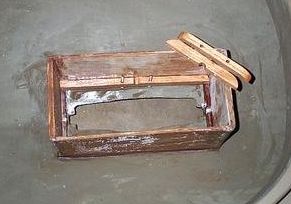
Placement of the hole is probably just as important as the shape of the hole. The pedals on the mirage drive will adjust for different pedaling positions, which is really good for some minor adjustment for different body sizes. It is important to start at a position that will allow comfortable pedaling for the primary user of the boat. Also keep in mind that the pedals will need room for travel above the trunk. Keep two inches or more ahead of the trunk for full pedal travel when using the longest pedal position.
The next critical element in the installation is
the trunk. The width and length of the trunk are largely dictated by the 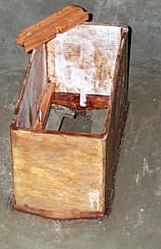 dimensions of the drive. The smallest trunk would probably be some sort of long
octagon. A simple box seemed to be a lot more practical for me, especially
since I had a "V" bottom to contend with as well. The height of the
trunk is also very important and will probably vary with each application. Too
low and you will have trouble with water entering (and sinking) the boat. Too
tall and it will limit the travel of the pedals. It will also make it difficult
to pedal since your feet will be hitting or dragging on the trunk unless you
point your toes to clear the trunk. A height of about 8 inches seems to be a
good rough estimate. Boats that draft more than 5 or so inches when fully
loaded are probably not good candidates for a mirage drive.
dimensions of the drive. The smallest trunk would probably be some sort of long
octagon. A simple box seemed to be a lot more practical for me, especially
since I had a "V" bottom to contend with as well. The height of the
trunk is also very important and will probably vary with each application. Too
low and you will have trouble with water entering (and sinking) the boat. Too
tall and it will limit the travel of the pedals. It will also make it difficult
to pedal since your feet will be hitting or dragging on the trunk unless you
point your toes to clear the trunk. A height of about 8 inches seems to be a
good rough estimate. Boats that draft more than 5 or so inches when fully
loaded are probably not good candidates for a mirage drive.
The mechanism to lock the drive in place could use some improvement. If you look at a Hobie Outback (the boat the drive is designed for) you will see a very elegant mechanism for keeping the drive in place.
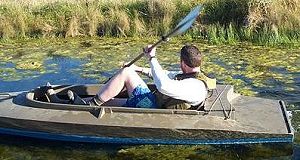
Here I was intentionally trying to get the boat stuck in the thick weeds and algae. I did manage to get it stuck but, it goes through a good deal of weeds with little fuss. |
The test cruise revealed the need to make a rudder. I can steer with the kayak paddle, but a rudder just makes things so much more pleasant. I had planned on using a rope type system but later decided on a push rod. The push rod slips into the hole in the control arm and falls comfortably where my right hand can control it.
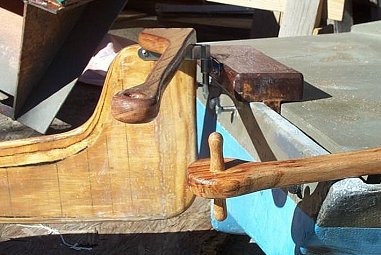
I still need to perform a fresh sink test with the trunk in place. Having a hole in the middle of the boat may change the characteristics of the boat more than you might expect. I expect the trunk will allow some water OUT if I attempt to fill it full of water. It may be difficult or impossible to bail the cockpit enough to re-enter the boat or, it could be easier to right the boat and get enough water out to re-enter. Only actual experience and testing will give the answers I need.
So cutting a hole in the bottom of a boat has turned out be a great idea for someone who likes to tinker as much as I do.
* The Glen-L Sneak Box has a sail plan.